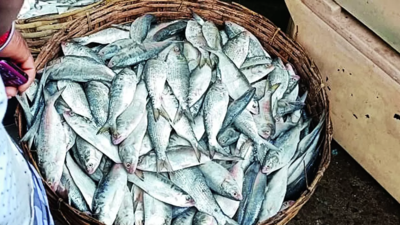- News
- City News
- kolkata News
- First hilsa catch this season yields only banned khoka ilish
Trending
First hilsa catch this season yields only banned khoka ilish

Juvenile hilsas that reached a market in Diamond Harbour from Namkhana and Kakdwip on Tuesday
KOLKATA: Markets across the city have been flooded with juvenile hilsa with recent catch — the season’s first — netting around 200 tonnes of the prized fish with an average weight of only 200 grams. This has led to serious concerns among marine scientists about the health of the hilsa population and they have warned that such unsustainable fishing practices could lead to a dearth in hilsa catch not just in this season but in years to come.
Fishing juvenile hilsa is banned and fishermen are supposed to use larger nets during this season to allow juvenile hilsa to escape.
Bangladesh has managed to effectively enforce the ban on catching juvenile hilsa and allowed it to propagate.
The volume of catch in Bengal has, however, not improved, primarily owing to poor fishing practices. The haul of 30 tonnes of small hilsa at Kakdwip and Namkhana port that were sold at the Diamond Harbour Nagendra wholesale market early on Tuesday has again triggered alarm bells.
At the Diamond Harbour wholesale market, Monday’s rates ranged from Rs 137 to Rs 185 per kilogram. But, prices on Tuesday saw fluctuations with some vendors selling the fish for Rs 300 while others charged as high as Rs 350.
Concerns have been raised regarding the methods employed to catch these fish. Many fishermen using grill nets fail to adhere to the correct measurement standards, which is 90cm and above.
Bijon Maity of Kakdwip Fishermen Association called for an end to such practices. “Repercussions of unsustainable fishing methods would not only deprive people of hilsa but also impact livelihoods of thousands of fishermen dependent on it,” he added. Debasish De, principal scientist at Indian Council of Agricultural Research-Central Institute of Brackishwater Aquaculture (ICBA-CIBA) Kakdwip Research Centre, highlighted the fact that fish are being caught before they can reproduce.
Piyal Sardar, additional director of fisheries, said, “We have got photographs. Let’s see what we can do.”
Fishing juvenile hilsa is banned and fishermen are supposed to use larger nets during this season to allow juvenile hilsa to escape.
Bangladesh has managed to effectively enforce the ban on catching juvenile hilsa and allowed it to propagate.
The volume of catch in Bengal has, however, not improved, primarily owing to poor fishing practices. The haul of 30 tonnes of small hilsa at Kakdwip and Namkhana port that were sold at the Diamond Harbour Nagendra wholesale market early on Tuesday has again triggered alarm bells.
Fisherman are in high demand due to their affordable prices, attracting vendors who see an opportunity for increased profits with minimal investment. Availability of such inexpensive fish has caught the attention of the middle-class populace, with areas like Behala, Thakurpukur, Tollygunge, Karunamoyee, Kasba, and even Maniktala witnessing an upsurge in sales.
At the Diamond Harbour wholesale market, Monday’s rates ranged from Rs 137 to Rs 185 per kilogram. But, prices on Tuesday saw fluctuations with some vendors selling the fish for Rs 300 while others charged as high as Rs 350.
Concerns have been raised regarding the methods employed to catch these fish. Many fishermen using grill nets fail to adhere to the correct measurement standards, which is 90cm and above.
Bijon Maity of Kakdwip Fishermen Association called for an end to such practices. “Repercussions of unsustainable fishing methods would not only deprive people of hilsa but also impact livelihoods of thousands of fishermen dependent on it,” he added. Debasish De, principal scientist at Indian Council of Agricultural Research-Central Institute of Brackishwater Aquaculture (ICBA-CIBA) Kakdwip Research Centre, highlighted the fact that fish are being caught before they can reproduce.
Piyal Sardar, additional director of fisheries, said, “We have got photographs. Let’s see what we can do.”
Start a Conversation
FOLLOW US ON SOCIAL MEDIA
FacebookTwitterInstagramKOO APPYOUTUBE










